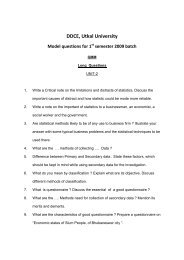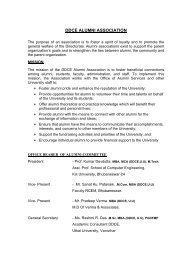Marketing Management - DDCE, Utkal University, Bhubaneswar
Marketing Management - DDCE, Utkal University, Bhubaneswar
Marketing Management - DDCE, Utkal University, Bhubaneswar
Create successful ePaper yourself
Turn your PDF publications into a flip-book with our unique Google optimized e-Paper software.
<strong>DDCE</strong>, <strong>Utkal</strong> <strong>University</strong><br />
Model questions for 1 st semester 2009 batch<br />
MM<br />
Dr. B.B. Mishra<br />
Long type questions<br />
Unit – I<br />
1. “<strong>Marketing</strong> is a system of integrated business activities designed to<br />
develop strategic plans leading to the satisfaction of customer wants in<br />
selected market segments”. Explain the statement and bring out the<br />
important concepts involved in marketing.<br />
2. “Customer is the king”. Comment as the statement and highlight the<br />
modern concepts of marketing.<br />
3. “Instead of trying to sell what we can make; we must make what we can<br />
sell”. Critically examine the statement and bring out the differences<br />
between the concepts involved in this statement with suitable examples.<br />
4. Define marketing and explain the marketing management process briefly.<br />
Give suitable examples from Indian context.<br />
5. Define marketing management and explain the nature, scope and<br />
functions of marketing in 21 st century.<br />
6. The present-day marketing is consumer – oriented. Explain the concept<br />
and identify the objectives of modern business.<br />
7. Discuss the role of marketing in the economic development process of a<br />
nation by highlighting its role in economic development of India.<br />
8. What is a marketing mix? Illustrate the producers 4ps and its equivalent<br />
consumers 4 Cs concept. Comment upon in brief the ingredients of<br />
marketing mix.<br />
9. “Marketers can create needs and also can satisfy them’. Do you agree?<br />
Give reasons to support your answers.<br />
10. Identify some recent changes in the market place. Briefly discuss their<br />
influences as marketing strategy of a firm with examples.<br />
11. Explain with suitable examples, how an organization can achieve its<br />
objectives by adopting proper marketing strategy.<br />
12. State and analyse various definitions of marketing. Bring out the care<br />
concepts of marketing.<br />
13. Critically examine the evolution of marketing in modern era by highlighting<br />
the significant difference in each stage.<br />
14. Define marketing environment and examine different types of such<br />
environments with suitable examples.<br />
15. What is marketing environment? Examine the importance of<br />
understanding the marketing environment information of suitable<br />
marketing strategy of a firm.<br />
1
16. in a multi-ethnic country like India, how could cultural environment affects<br />
the marketing strategy of a firm? Explain with some examples from Indian<br />
environment.<br />
17. How could a firm understand its marketing environment? Suggest the<br />
environmental scanning process briefly.<br />
18. Mention uncontrollable variables influencing the marketing strategy of a<br />
firm. Examine them with suitable examples from Indian environment.<br />
19. What can be the possible effects of changes in government’s fiscal and<br />
economic policies an marketing environment? Elaborate with suitable<br />
examples.<br />
20. What is ‘PEST’ method of environmental scanning? Explain the utility of<br />
PLC concept for technological environmental scanning.<br />
2
Unit – II<br />
1. Define a strategy. Indicate the role and importance of marketing strategy<br />
for success of a business.<br />
2. Define marketing information system (MIS). What are its elements ?<br />
Discuss MIS as an integrated model by identifying the inter-relationship<br />
among its elements.<br />
3. Define marketing research (MR) and explain its significance in customer<br />
oriented marketing policies and plans.<br />
4. What is a questionnaire? What is its purpose? How will you design a<br />
questionnaire?<br />
5. Define a market, Discuss the concept of market from the view point of a<br />
company as well as the buyer.<br />
6. What do you mean by market segmentation? What are its benefits?<br />
Discuss the market segmentation process briefly.<br />
7. “Market segmentation is important for target markets strategy”. Discuss<br />
different types of targeting strategy with suitable examples.<br />
8. Differentiate between industrial markets and consumer markets. How will<br />
you go for segmenting industrial markets? Give suitable examples in India<br />
context.<br />
9. Define marketing information system (MIS) and discuss its importance in<br />
modern business. Describe the process of developing an MIS for an<br />
organization.<br />
10. Discuss the marketing research (MR) process for introduction of a new<br />
product. Highlight the limitations of MR in such case.<br />
11. In modern Indian perspective, how culture influences the consumer<br />
behaviour and the purchasing decisions? Give suitable examples to<br />
explain the products used by the consumers are culturally oriented.<br />
12. ORG has made a study to collect consumer feedback on ‘stop the obesity<br />
epidemic’ campaign. The study was helpful in gathering valuable<br />
information as consumers’ requirements with regard to healthy food<br />
choice. What are the important factors to be considered for this study?<br />
Suggest suitable research methodology for conducting such studies.<br />
13. Define a consumer problem and discuss the consumer decision process<br />
briefly for the following products.<br />
a. Readymade garments<br />
b. Fairness cream<br />
c. A personal computer<br />
14. Identify the factors which influence the consumer. Decision process.<br />
Explain them with suitable examples.<br />
15. Define CRM and what are its main focuses? Discuss the importance of<br />
CRM in modern marketing.<br />
16. What do you mean by sales forecasting? Examine different methods of<br />
sales forecasting suggesting the suitable method in a recession period.<br />
3
17. define a model and explain how is it helpful in explaining the theory?<br />
Critically evaluate Howard – Sheth Buying behaviour model.<br />
18. What do you mean by post-purchase dissonance. How the consumer try<br />
to reduce it? Explain the importance of post-purchase evaluation in the<br />
consumer decision process.<br />
19. Positioning is a deliberate exercise. All such exercises to promote an<br />
image have elements of imaginative untruths. Is positioning notion attempt<br />
to mislead customers? Explain with examples.<br />
20. Do customers see themselves as belonging to separate segments? If they<br />
do not; will they value the special efforts made by the markets to please<br />
them? Substantiate with examples.<br />
4
Unit – III<br />
1. Define a product and identify its layers of the product Elaborate in brief the<br />
various view points explaining the concept of a product.<br />
2. A leading consumer durable company is interested in modifying its product<br />
mix. What factors will you consider for this analysis? Elaborate them with<br />
examples.<br />
3. What is meant by product differentiation? Compare the advantages of<br />
product differentiation and market segmentation. Which are you will<br />
recommend for a new product.<br />
4. Define product life cycle (PLC) as a marketing tool. Briefly describe each<br />
of the four main stages of the PLC.<br />
5. What are the major decisions involved in product management? Give a<br />
schematic diagram of classification of products.<br />
6. Define a new product and discuss the role of innovation in new product<br />
development. Discuss the new product from different perspectives.<br />
7. There is no guarantee a new product introduced to the market will bring<br />
fortune for the firm. Comment as the statement and discuss the factors<br />
contributing to success and failure of a new product.<br />
8. New product development is a tricky situation. Discuss the role of idea<br />
generation and idea screening for success of a new product.<br />
9. Give examples of some new products recently launched in to the market.<br />
Suggest the steps for diffusion and adoption of the new product in the<br />
Indian market.<br />
10. Out line the various stages in new product development by suggesting a<br />
flow chart diagram for the same.<br />
11. A company has just added an electronic cordless mosquito repellant to its<br />
product line. The product is targeted to middle class households with a<br />
price tag of Rs.2000/- The co approached you for its positioning. Workart<br />
a positioning strategy and its rationale for this wonder product.<br />
12. Brand is an important asset of a firm. It is extremely useful in case of<br />
negotiations for takeovers. Explain with suitable examples.<br />
13. What do you mean by a brand? Discuss, how branding and packaging<br />
serve the major role is managing products?<br />
14. Often the marketers face the challenges of branding or not branding a<br />
product. Analyse the statement and suggest the important decisions the<br />
marketer will take in branding the product.<br />
15. Discuss the importance of packaging as a tool for product differentiation<br />
and market development by giving suitable examples from Indian<br />
environment.<br />
16. Labels are the legal requirements and the companies must comply to<br />
these requirements. Find out various legal provisions for labels under<br />
Trade Mark Acts in India including its violations.<br />
5
17. Describe the significance of pricing in marketing. Identify the factors,<br />
which influences the price setting strategy of a firm.<br />
18. A firm has to consider many factors in setting its pricing policy. Describe<br />
the procedure for setting the price of a firm.<br />
19. How should the price be adopted to meet the varying circumstances and<br />
the opportunities in the environment? Elaborate with suitable examples.<br />
20. Most often the rival firms change their prices to capture the market. What<br />
should the firm do when rivals change their prices? When should the<br />
company initiate a price change; and how should it respond to a<br />
competitions prices change?<br />
6
Short questions<br />
Unit – II<br />
1. Test of Reliability and validity<br />
2. Requisites of a good questionnaire.<br />
3. Different types of personal interview methods<br />
4. Distinction between explanatory and descriptive designs.<br />
5. How does marketing research make use of scientific methods?<br />
6. Difference between differentiated and undifferentiated marketing.<br />
7. Meaning and importance of marketing decision support system.<br />
8. External vs internal information sources and their use.<br />
9. Define the scope of marketing research.<br />
10. Explain different types of consumer needs and their relevance in<br />
marketing.<br />
11. Buying process roles of a consumer.<br />
12. Discuss children as influences in the consumption process.<br />
13. Examine the reference group influences as the consumer.<br />
14. Explain with examples life-style marketing.<br />
15. Suggest methods of meaning social class in understanding buyer<br />
behaviour.<br />
16. how to reduce post-purchase dissonance of a consumer<br />
17. Elaborate the bases for market segmentation.<br />
18. Discuss different types of target marketing strategies with suitable<br />
examples.<br />
19. Data mining and data warehousing technology in CRM.<br />
20. Type of consumers and their characteristics.<br />
7
Unit – III<br />
1. PLC for fashion and fads – discuss.<br />
2. Define product mix and discuss its dimensions.<br />
3. stages in the trial and adoption process.<br />
4. Give examples of different layers of the product.<br />
5. Identify the factors which influences the trial – adoption rates.<br />
6. How to respond to aggressive price cutters?<br />
7. Discuss the price-quality strategies of a firm.<br />
8. Describe in brief the impact of price discrimination.<br />
9. What is perceived value pricing?<br />
10. Return-on-Investment (ROI) – a tool of measuring efficiency business and<br />
also a control tool.<br />
11. Significance of different types of packaging in marketing.<br />
12. Differentiate between ‘too-long’ and ‘too-short’ product lines and discuss<br />
its importance in product management.<br />
13. How would you measure the attractiveness of market offerings?<br />
8
Unit – I<br />
Objective questions<br />
1. <strong>Marketing</strong> as exchange process<br />
2. define marketing<br />
3. Production concept of marketing<br />
4. Product concept of marketing<br />
5. Meta marketing<br />
Unit- II<br />
1. Sampling error.<br />
2. Extraneous variables<br />
3. Psychographic segmentation<br />
4. Behavioural segmentation<br />
5. <strong>Marketing</strong> intelligence system<br />
6. Causal research<br />
7. Role of consumer initiators.<br />
Unit- III<br />
1. Line filing<br />
2. Line stretching<br />
3. Concept development<br />
4. Rapid vs slow skimming<br />
5. Premium products.<br />
6. Consumer innovators<br />
7. Trickle – down theories<br />
8. Relative advantages of a new product.<br />
9. Mark – up pricing<br />
10. Cost – plus pricing methods.<br />
11. Up-ward stretch of product line.<br />
12. Two-way stretch of product line<br />
13. Just-noticiceable difference (JND)<br />
14. Brand pruning decisions<br />
15. Six – levels of brand meaning.<br />
16. Meaning of brand equity.<br />
17. Characteristics of innovative<br />
18. Stages in consumer adoption<br />
19. Simulate test marketing<br />
20. Sales ware research<br />
9



